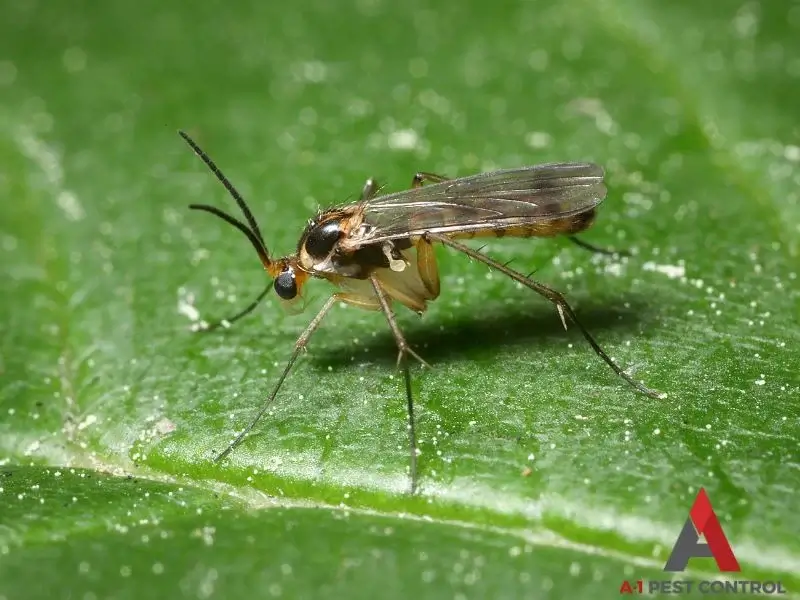
Fungus Gnats
Fungus gnats are a common nuisance in North Carolina, especially in homes, offices, and indoor gardens. These tiny, mosquito-like insects may seem harmless, but their presence can lead to major consequences for houseplants and seedlings.
Understanding these little pests can make it easier to get rid of them—and keep them out. Our pros at A-1 Pest Control have your guide to fungus gnats in North Carolina, and the right plan to tackle them.
What Are Fungus Gnats?
Fungus gnats are delicate, grayish-black insects that look a lot like small mosquitoes, measuring about 1/8 inch in length. They have long legs, a single pair of clear wings, and segmented antennae longer than their heads. Their larvae, often found in damp, rich soils, are 1/4 inch long with shiny black heads and elongated, translucent bodies. These larvae thrive in environments rich in organic matter, feeding on fungi, root hairs, and decaying plant material.

Although adult fungus gnats are harmless and do not bite, they can become a nuisance when their population grows, especially in homes and offices near houseplants. The larvae, however, pose a bigger threat: They develop in plant-growing mediums, potentially damaging houseplants, seedlings, and cuttings.
Life Cycle and Behavior of Fungus Gnats
Fungus gnats undergo a four-stage life cycle: egg, larva, pupa, and adult. This process takes only a few days to complete, allowing populations to grow rapidly under favorable conditions.
Adults thrive in warm, moist soils, making overwatered houseplants an ideal breeding ground. With multiple generations possible in a short time, it’s crucial to address infestations as soon as possible to prevent their spread.
The Dangers of Fungus Gnats
They may not bite, but that doesn’t mean they’re completely harmless. Here’s how infestations can impact your garden:
- Damage to Plant Roots: Fungus gnat larvae feed on root hairs and organic material, stunting the growth of young plants and seedlings.
- Visible Plant Symptoms: Infested plants may exhibit yellowing, wilting, and poor growth. In severe cases, plants may fail entirely.
- Vulnerable Plants: Seedlings, cuttings, and young plants are especially susceptible to injury from fungus gnats.
Causes of Fungus Gnats
Several factors contribute to fungus gnat infestations, many of which are tied to moisture and soil conditions:
- Overwatering: Excess moisture in the soil creates an ideal environment for fungus gnat larvae.
- Poor Drainage: Waterlogged soils allow larvae to thrive and mature into adults.
- Contaminated Soil or Plants: Infestations can also spread through the introduction of contaminated potting soil or infected plants.
Preventing and Controlling Fungus Gnats
Effective management of fungus gnats requires targeting both the adult insects and their larvae.
Target Larvae in the Soil
Eliminating fungus gnats requires a multi-pronged approach to effectively target their entire life cycle and prevent re-infestation. One of the easiest ways to prevent fungus gnats is to target them in the soil. Use nematodes or predatory mites to naturally attack larvae. Top-dress plant soil with sand to prevent adults from laying eggs.
Trap Adult Fungus Gnats
When it comes to adult fungus ants, getting rid of them can be best done through the use of traps.
Deploy yellow sticky traps to monitor and reduce adult populations. Homemade traps or pheromone-based lures can also be effective.
Improve Watering Practices
Soil that is too moist can create an ideal habitat for fungus gnats, so try to avoid overwatering and allow the soil to dry out between watering sessions. Ensure pots have adequate drainage to prevent standing water.
Use Multiple Control Methods
Combine a variety of strategies for maximum impact. Sticky traps are a great starting point to capture adult gnats and monitor their population levels. Beneficial nematodes, which are microscopic organisms that prey on fungus gnat larvae in the soil, can significantly reduce the population before it matures into adults.
Soil treatments such as insecticidal soaps or natural larvicides can also help target the larvae directly, disrupting their development.
Repeat Treatments
Because fungus gnats have a short but overlapping life cycle, it’s crucial to reapply treatments regularly. Adults can lay eggs rapidly, and larvae often survive initial treatments. By repeating control measures every few days, you ensure that new generations are eliminated before they can reproduce, breaking the cycle entirely.
Maintain Clean Growing Areas
Keeping your growing spaces tidy is a cornerstone of fungus gnat prevention. Remove dead leaves, organic debris, and excess mulch from the soil surface, as these provide ideal breeding grounds for gnats.
Avoid overwatering your plants, as fungus gnats thrive in moist environments. Allowing the top layer of soil to dry out between waterings makes it less hospitable to these pests.
Consider Professional Pest Control
If your fungus gnat problem persists despite your efforts, professional pest control services can provide a comprehensive solution. Trained technicians have access to advanced tools and treatments that effectively target fungus gnats at all stages of their life cycle. Professionals can also assess your environment, identify potential problem areas, and provide tailored recommendations to ensure long-term pest prevention.
What May Be Causing Fungus Gnats in Your Home?
To locate the source of fungus gnats, focus on areas with excessive moisture and organic material. Common sources include overwatered houseplants, poorly drained soil, and decaying plant debris.
Start by inspecting the soil of houseplants, particularly those that stay consistently damp. You may also notice adult fungus gnats flying near these plants or gathering around drains, trash cans, or other areas with moisture. Using yellow sticky traps can help you monitor and pinpoint the areas with the most significant fungus gnat activity.
Do Fungus Gnats Indicate the Presence of Mold?
While fungus gnats do not directly indicate the presence of mold, they are often attracted to environments where mold thrives. Fungus gnat larvae feed on fungi and decaying organic matter in moist soil, so their presence can sometimes coincide with mold growth in overwatered plants or damp areas. However, the gnats themselves do not cause mold and are not an indicator of a mold infestation.
Contact A-1 Pest Control for Fungus Gnat Extermination
Fungus gnats are a common but manageable pest in North Carolina. If you’re struggling with a persistent fungus gnat infestation, contact A-1 Pest Control at 828-481-9140 or fill out the form below for professional assistance. Our experienced team can help you eliminate fungus gnats for good.

